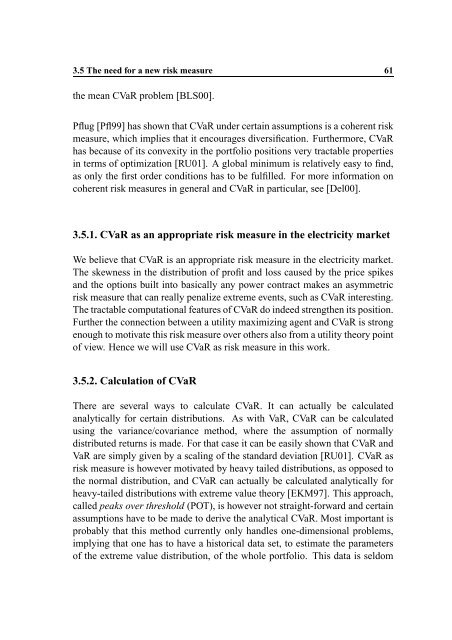Hedging Strategy and Electricity Contract Engineering - IFOR
Hedging Strategy and Electricity Contract Engineering - IFOR
Hedging Strategy and Electricity Contract Engineering - IFOR
Create successful ePaper yourself
Turn your PDF publications into a flip-book with our unique Google optimized e-Paper software.
3.5 The need for a new risk measure 61<br />
the mean CVaR problem [BLS00].<br />
Pflug [Pfl99] has shown that CVaR under certain assumptions is a coherent risk<br />
measure, which implies that it encourages diversification. Furthermore, CVaR<br />
has because of its convexity in the portfolio positions very tractable properties<br />
in terms of optimization [RU01]. A global minimum is relatively easy to find,<br />
as only the first order conditions has to be fulfilled. For more information on<br />
coherent risk measures in general <strong>and</strong> CVaR in particular, see [Del00].<br />
3.5.1. CVaR as an appropriate risk measure in the electricity market<br />
We believe that CVaR is an appropriate risk measure in the electricity market.<br />
The skewness in the distribution of profit <strong>and</strong> loss caused by the price spikes<br />
<strong>and</strong> the options built into basically any power contract makes an asymmetric<br />
risk measure that can really penalize extreme events, such as CVaR interesting.<br />
The tractable computational features of CVaR do indeed strengthen its position.<br />
Further the connection between a utility maximizing agent <strong>and</strong> CVaR is strong<br />
enough to motivate this risk measure over others also from a utility theory point<br />
of view. Hence we will use CVaR as risk measure in this work.<br />
3.5.2. Calculation of CVaR<br />
There are several ways to calculate CVaR. It can actually be calculated<br />
analytically for certain distributions. As with VaR, CVaR can be calculated<br />
using the variance/covariance method, where the assumption of normally<br />
distributed returns is made. For that case it can be easily shown that CVaR <strong>and</strong><br />
VaR are simply given by a scaling of the st<strong>and</strong>ard deviation [RU01]. CVaR as<br />
risk measure is however motivated by heavy tailed distributions, as opposed to<br />
the normal distribution, <strong>and</strong> CVaR can actually be calculated analytically for<br />
heavy-tailed distributions with extreme value theory [EKM97]. This approach,<br />
called peaks over threshold (POT), is however not straight-forward <strong>and</strong> certain<br />
assumptions have to be made to derive the analytical CVaR. Most important is<br />
probably that this method currently only h<strong>and</strong>les one-dimensional problems,<br />
implying that one has to have a historical data set, to estimate the parameters<br />
of the extreme value distribution, of the whole portfolio. This data is seldom
















